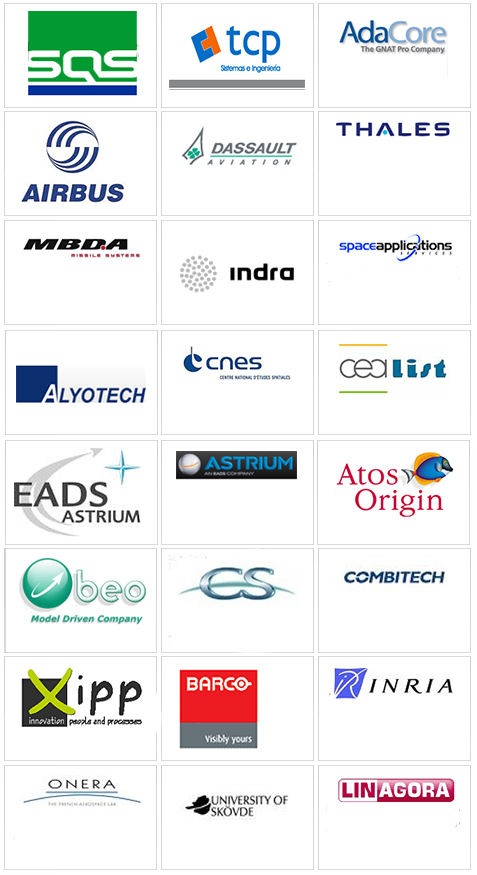Project Description
The mission of OPEES is to ensure the long-term availability of innovative engineering tools and technologies in the field of built-in systems based on the intensive use of software. For the participants and collaborators of OPEES, this challenge can be achieved if it´s possible to build an ecosystem in the Open Source framework, with the appropriate business models that ensure long-term availability.
- An open and visible organisation with European and global dimensions, implementing the models / business plans and the dissemination plan defined for the project, allowing the emergence of a European service industry.
- A common vision and roadmap that allow to share collaborative R&D&i project results and to build upon them so as to ensure the consistency and complementarity of future R&D&i projects undertaken for completing the set of engineering tools.
- An open technical repository that will contain an initial set of components and tools which have been matured and assessed according to OPEES methodologies and that will support the collaborative work around these components.
- A set of processes and guides for maturing and assessing the candidate components or tools by experimentation, based on real use cases that ensure their durability and interoperability through the creation of standards (consistent with industrial needs and domain restrictions).
Collaborating Companies or Organisations
Indra's Role
OPEES´ interest is motivated because it offers real time R&D&i solutions for embedded systems that are applicable to domotics systems, emergency systems and security systems. In these projects, it´s necessary to communicate the semantic reasoners with the physical devices (tools for decision making).
Contribution details by work package
WP1 (organisation and management)
Indra will contribute in all the management and coordination activities, it will participate in preparing reports and external reviews (on a national and ITEA level), focused on:
- Business models
- Operational processes, norms, standards and agreements for service levels and maintenance.
- Legal aspects.
- Internal resolution of conflicts of interest (example: Different company departments).
This entails a contribution in tasks T1.1, T1.2 and T1.3.
WP2 (technical roadmap)
Indra will participate actively in all the pending tasks for this work package, especially focusing its efforts on defining processes for the development stack of OPEES applications and on applying existing solutions and frameworks to the needs of the OPEES project. Indra will contribute its extensive knowledge of existing development platforms (see the list of R&D projects completed by Indra).
WP3 (systems engineering platform with long-term availability)
Indra will participate in the definition and specification of technologies, methods, processes and tools for ensuring the long-term availability of OPEES components, extending the art status to various fronts through its experience in requirements engineering, analysis, design, implementation, development, testing, validation, verification and certification.
WP4 (implementation and validation)
Indra will contribute to the package with its extensive experience as an applications developer and integrator, designing and implementing the architecture as well as the tools and services. It will also carry the leadership weight for this package by performing the corresponding coordination tasks.
WP5 (Distribution)
The need for distribution activities is especially important to OPEES for the penetration and general acceptance of the proposed concepts and methods.
Indra will distribute the OPEES results via:
- Publications in magazines, internationally renowned newsletters, and conferences.
- Organising workshops in parallel to important industry conferences and events.
- Producing training materials and organising courses about OPEES technologies and platforms.
- Demonstrating the industrial capacities of the OPEES platform.
- Using available pilot developments as a demonstration of the OPEES platform´s capabilities. Meetings with interested parties will be organised at development offices in order to distribute the project results and to explain the platform´s capacities to potential users.
Universities and Technological Centres
Technologies used
One of the most technologically important aspects of OPEES is preparing a technical roadmap for the development of engineering tools. This includes the development of advanced modelling techniques based primarily on UML2 and extensions that allow to increase productivity in this domain. It´s important to highlight that there are Spanish-based open modelling tools with a relevant success in the market and which will participate relevantly in the project.
Tools and technologies used:
- Modelling and simulation: TOPCASED, Papyrus, Moskitt, EMF, PLUM.
- Interoperability: Rose, Rhapsody.
- Code generation: Gene Auto, GMF, ATL- Modelling standards: UML, SysML, AADL, MARTE.
- IDEs: Eclipse and specific plug-ins (such as EPF Componer).
- Model verification: TopcasedOCL, TINA, CADP, AGATHA.
- Code analysis: FRAMA-C, Fluctuat, Astrée, WCET, Snack Analyzer, Polyspace.
- Remote communication architectures: XMI, SOA.
- Infrastructure virtualisation: UMISIM.
- Maturity and quality: Safety CMMI, Automotive SPICE.
More information
This project, under the code TSI-020400-2010-36, has been co-funded by the Ministry of Industry, Energy and Tourism as part of the 2008-2011 National Scientific Research, Development and Technological Innovation Plan.


